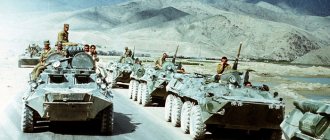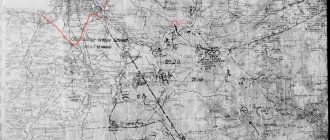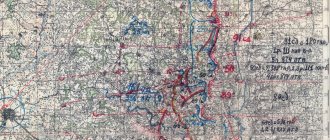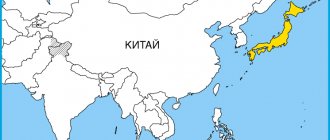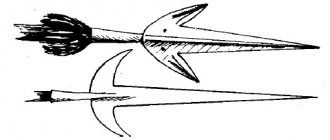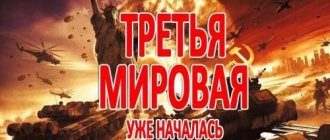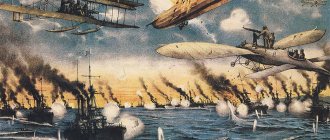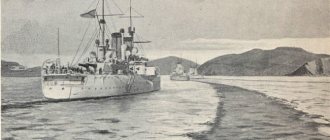This is a sub-article to the article Author's Guide/World War II/Course of hostilities. Blocks and navigation templates are not needed here.
| Construction site, put on your hard hat! This article is currently in the process of being written. The author plans something voluminous and inserts the text here in parts. Please wait until the work is completed, and only then edit: do not create inconvenience for yourself and the author. |
(link)
War in the Pacific
Japan, not particularly happy with the terms of the agreements signed in Washington (limiting the Japanese fleet to 60% of the British and American fleet, a ban on the militarization of island territories that fell to the Japanese as a result of the First World War[1] and a temporary stop to Japanese expansion into China), began to prepare ahead of time for revenge .
In the 30s, a new shipbuilding program was adopted - all the old battleships (and there were ten of them - four battlecruisers of the Kongo type and two battleships of the Fuso, Ise and Nagato types each), Akagi aircraft carriers Both the Kaga and heavy cruisers were sent for major modernization, and construction began on two more pairs of large aircraft carriers and two Yamato-class battleships. In addition, a “shadow program” was launched for the construction of warships - 7 (!) ships (three submarine motherships, two seaplane motherships and two ocean liners for the 1940 Olympics) were built taking into account the fastest possible conversion into aircraft carriers, six new conditionally light cruisers were built with the possibility of replacing the main caliber with a 203 mm gun. In addition, all Japanese ships, including heavy cruisers[2], were equipped with torpedo tubes with 610-mm oxygen torpedoes, and their crews were trained to fight in night conditions.
War in the Pacific
In military history, it is customary to count the beginning of hostilities in the Pacific Ocean back to 1931, when militaristic Japan invaded Manchuria. The offensive began in September, and by January 7, 1932, the Japanese reached the Great Wall of China and then continued their occupation. Slowly but surely. Beijing, Shanghai, Nanjing - all the main cities of the Celestial Empire fell after stubborn resistance and Japan came close to the territory of its other eternal enemy - Russia. Now the enemy was called the USSR and was completely focused on the growing Western threat, but was forced to be torn on two fronts. Local battles continued for more than a decade, but the war in the Pacific truly began on December 7, 1941, when the Japanese fleet under the command of Vice Admiral Nagumo Chuichi launched a swift and destructive attack on the Hawaiian base of Pearl Harbor. The catastrophic defeat shook up the indecisive White House administration, and the very next day President Franklin Roosevelt spoke in Congress, after which the United States declared war on Japan. Interesting articles
- The most fashionable dances of the 1960s
- Fashionable clothes of the 80s in the USA (men's and women's)
- History of the NBA logo
- Who are the Beats - history and photographs of the Beat Generation
Once they decide to pursue a certain goal, Americans rarely give up before they get what they want. This is exactly how events took place in the Pacific theater of operations, where both rivals demonstrated outstanding courage and patriotism. And the final chord was a military act unprecedented for mankind - a nuclear strike on enemy cities. On August 6 and 9, 1945, atomic bombs were dropped on Hiroshima and Nagasaki, respectively, after which the will of the Japanese army was broken. On the 15th, Emperor Hirohito announced surrender and Japan's difficult time after the war began. Although some military units continued to fight the Soviet army in Manchuria for another month.
Beginning of the conflict
By the beginning of July 1941, the Japanese army, despite protests from the governments of America and Great Britain, captured the southern part of Indochina, and after a short time approached the Philippines, Singapore, the Dutch Indies and Malaya. In response, America imposed a ban on the import of all strategic materials into Japan and at the same time froze Japanese assets held in its banks. Thus, the war that soon broke out between Japan and the United States was the result of a political conflict that America tried to resolve with economic sanctions.
It should be noted that Tokyo's military ambitions extended up to the decision to seize part of the territory of the Soviet Union. Japanese Minister of War Tojo announced this at the imperial conference in July 1941. According to him, a war should have been started with the aim of destroying the USSR and gaining control over its rich natural resources. True, at that time these plans were clearly impracticable due to the lack of forces, the bulk of which were aimed at the war in China.
Color photographs of combat
Key battles in the Pacific theater include Okinawa, Iwo Jima, the Marshall Islands, Peleliu, Kiribati, Tarawa, Saipan and other battle scenes in a collection of photographs brought to life from black and white to color by Royston Leonard, a Welsh photographer and twentieth-century history enthusiast.
American soldiers of the 7th Infantry Division attack a Japanese outpost at Kwajalein in the Marshall Islands, 1944.
Marines fire a .30 caliber Browning M1919 machine gun on Peleliu Island.
Avenger crash after engine failure, photo from USS Bataan CVE-29, March 13, 1944.
Japanese Surrender Day. USS Missouri in Tokyo Bay, September 1945.
M4 Sherman tank on Bougainville Island, Papua New Guinea, February 1943.
Soldiers of the 1st US Marine Division. White Beach of Peleliu, September 1944.
Battle of Tarawa, Kiribati, 1943. Approximately 4,600 dead after a bloody battle.
Dead American soldiers.
Wounded Soldiers, New Georgia. More than 36 million people died during the Pacific War.
Kwajalein, Marshall Islands, 1944.
As soldiers approach from the rear, two United States Marines distract a Japanese sniper who is hiding in a church beneath Shuri Castle in Okinawa, 1945.
A captured wounded Japanese soldier on Kwajalein Atoll, Marshall Islands. During World War II, it is estimated that between 19,500 and 50,000 members of the Imperial Japanese Army surrendered to the Allies.
The US 1st Cavalry Division crosses the Pasig River in Manila, February 1945. About 41,500 American troops were reported missing or killed during the Pacific War.
Battle on Iwo Jima, Japan 1945. The battle lasted five weeks and was one of the bloodiest and most brutal of the entire war.
Survivors of the Japanese attack on the USS Indianapolis, August 1945. After the ship was sunk, sharks attacked the survivors.
A soldier and a stray kitten under a burnt-out Japanese tank, Tarawa 1943.
Flamethrowers in action. Mount Suribachi, Iwo Jima 1945.
This photo was taken during the Battle of Saipan, 30,000 soldiers and civilians were declared dead after the conflict.
Landing vehicles heading to the defenses on Peleliu, September 1944.
Near Butaritari Beach, Makin Atoll, November 1943.
The Battle of Peleliu begins, 1944.
Two Marines from the 2nd Battalion, 1st Marine Regiment during the fighting at Wana Ridge during the Battle of Okinawa, May 1945.
Marines fire mortars in the Solomon Islands.
Namur Beach, Kwajalein Atoll.
American soldier on Japanese ammunition boxes.
Artillery, Solomon Islands.
American M4 Sherman Killer tank on Kwajalein Atoll.
Soldiers of the 1st US Marines at Cape Gloucester, New Britain, Bismarck Archipelago, late December 1943.
The deck of the aircraft carrier USS Hornet CV-8 during the Battle of Midway, 1942.
Transfer of military equipment and soldiers, New Guinea in April 1944.
Japanese surrender
The shock of the bombing, which ended the years of the US war with Japan, was so great that Prime Minister Kantaro Suzuki addressed Emperor Hirohito with a statement about the need for a speedy cessation of all hostilities. As a result, just 6 days after the second atomic strike, Japan announced its surrender, and on September 2 of the same year the corresponding act was signed. The signing of this historical document ended the US-Japan War (1941-1945). It also became the final act of the entire Second World War.
According to available data, US casualties in the war with Japan amounted to 296,929 people. Of these, 169,635 are soldiers and officers of ground units, and 127,294 are sailors and infantrymen. At the same time, 185,994 Americans were killed in the war with Nazi Germany.
Links[edit]
- Cressman 2000, p. 84.
- ^ a b Potter and Nimitz 1960, p. 717.
- Potter and Nimitz 1960, pp. 759-60.
- ^ B s d e g Silverstone 1968, pp. 9-11.
- Potter and Nimitz 1960, pp. 651-62.
- Kafka & Pepperburg 1946, p. 185.
- ↑
Potter and Nimitz 1960, p. 751. - Ofstie 1946, p. 194.
- ↑
Potter and Nimitz 1960, p. 761. - ↑
Potter and Nimitz 1960, p. 765. - ^ a b Potter and Nimitz 1960, p. 770.
- ^ ab Ofstie 1946, p. 275.
Consequences for history
About 2.5 thousand American soldiers died, the Japanese lost only 64 people and 29 aircraft. Part of the US fleet was put out of action. The Japanese considered this a success. But at the same time, they did not take into account that some of the damaged battleships in Pearl Harbor were outdated examples from the First World War. Japan surprised everyone by carrying out such a rapid raid, but made several strategic mistakes.
It was the attack on Pearl Harbor that enabled Roosevelt to submit a request to Congress to enter the war on December 8, 1941:
“The United States of America was subjected to an unprovoked and cowardly attack by the naval and air forces of the Empire of Japan...I request Congress to declare a state of war...”
Shelling of Pearl Harbor
The order to prepare for an attack (Tenkai!) was given at 7:40 am by Lieutenant Commander Mitsuo Fuchida. The most famous of the three slogans is Torah! Torah! Torah! , meant that the enemy was completely taken by surprise. In addition to dropping bombs and torpedoes on the US fleet, the Japanese planned to launch torpedoes from submarines.
The planes were launched in waves so that the airstrikes were continuous. The first victim was the battleship Arizona, on board which more than a thousand people died. The next victim was the battleship Oklahoma and its 395 sailors.
The Japanese hoped that the United States would begin to withdraw its ships from the bay, and the sinking of one of them would block the exit. The states quickly figured out the plan, so the decision was made not to leave the bay...
Battleship Arizona burns after an explosion caused by a Japanese bomb
Soon, the navy and air force sent from other US bases to help Pearl Harbor. By that time, the Japanese had completed two phases of airstrikes. During the attack, the infrastructure of the Pearl Harbor base was damaged only slightly. The Japanese did not destroy the huge and clearly visible tanks with diesel fuel, necessary for the further operation of the fleet (4.5 million barrels of oil were stored).
This was because the attack on infrastructure and fuel supplies was to be carried out in the third phase of the attack. However, this did not happen, as the cautious Admiral Nagumo declared that the main goal - the neutralization of the US Pacific Fleet - had been achieved. This turned out to be a fatal mistake, because the effects of the 3rd phase of the attack could have disabled the port of Pearl Harbor for a very long time.
Attack on Pearl Harbor, still from the film of the same name
See also[edit]
- California in the American Civil War
- Genocide in California
- Oregon in the American Civil War
- Washington Territory in the American Civil War Washington in the American Civil War
- Idaho in the American Civil War
- Montana in the American Civil War
- Utah in the American Civil War
- Arizona Territory in the American Civil War

